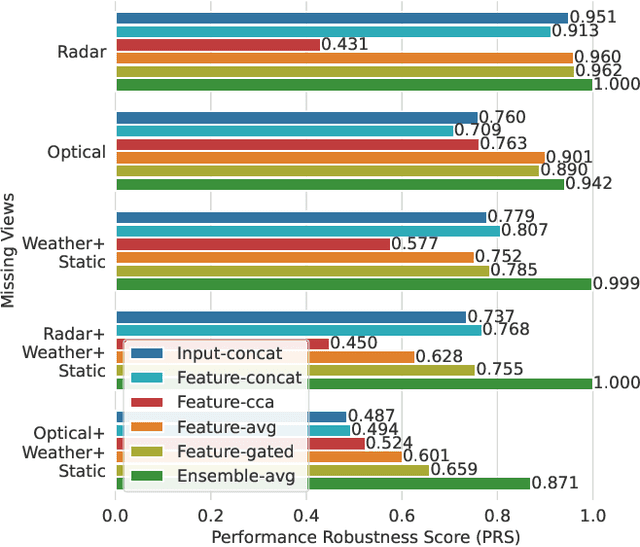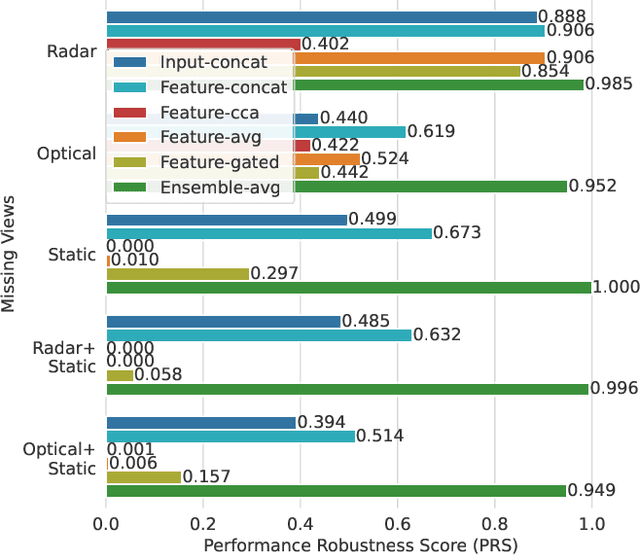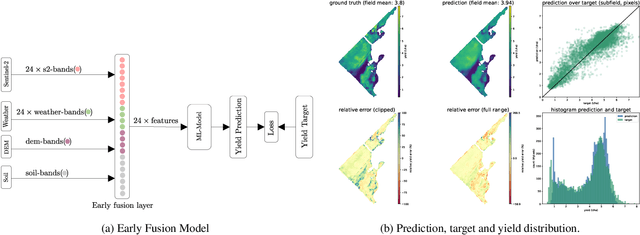Francisco Mena
An Analysis of Temporal Dropout in Earth Observation Time Series for Regression Tasks
Apr 09, 2025Abstract:Missing instances in time series data impose a significant challenge to deep learning models, particularly in regression tasks. In the Earth Observation field, satellite failure or cloud occlusion frequently results in missing time-steps, introducing uncertainties in the predicted output and causing a decline in predictive performance. While many studies address missing time-steps through data augmentation to improve model robustness, the uncertainty arising at the input level is commonly overlooked. To address this gap, we introduce Monte Carlo Temporal Dropout (MC-TD), a method that explicitly accounts for input-level uncertainty by randomly dropping time-steps during inference using a predefined dropout ratio, thereby simulating the effect of missing data. To bypass the need for costly searches for the optimal dropout ratio, we extend this approach with Monte Carlo Concrete Temporal Dropout (MC-ConcTD), a method that learns the optimal dropout distribution directly. Both MC-TD and MC-ConcTD are applied during inference, leveraging Monte Carlo sampling for uncertainty quantification. Experiments on three EO time-series datasets demonstrate that MC-ConcTD improves predictive performance and uncertainty calibration compared to existing approaches. Additionally, we highlight the advantages of adaptive dropout tuning over manual selection, making uncertainty quantification more robust and accessible for EO applications.
On What Depends the Robustness of Multi-source Models to Missing Data in Earth Observation?
Mar 25, 2025Abstract:In recent years, the development of robust multi-source models has emerged in the Earth Observation (EO) field. These are models that leverage data from diverse sources to improve predictive accuracy when there is missing data. Despite these advancements, the factors influencing the varying effectiveness of such models remain poorly understood. In this study, we evaluate the predictive performance of six state-of-the-art multi-source models in predicting scenarios where either a single data source is missing or only a single source is available. Our analysis reveals that the efficacy of these models is intricately tied to the nature of the task, the complementarity among data sources, and the model design. Surprisingly, we observe instances where the removal of certain data sources leads to improved predictive performance, challenging the assumption that incorporating all available data is always beneficial. These findings prompt critical reflections on model complexity and the necessity of all collected data sources, potentially shaping the way for more streamlined approaches in EO applications.
Missing Data as Augmentation in the Earth Observation Domain: A Multi-View Learning Approach
Jan 02, 2025



Abstract:Multi-view learning (MVL) leverages multiple sources or views of data to enhance machine learning model performance and robustness. This approach has been successfully used in the Earth Observation (EO) domain, where views have a heterogeneous nature and can be affected by missing data. Despite the negative effect that missing data has on model predictions, the ML literature has used it as an augmentation technique to improve model generalization, like masking the input data. Inspired by this, we introduce novel methods for EO applications tailored to MVL with missing views. Our methods integrate the combination of a set to simulate all combinations of missing views as different training samples. Instead of replacing missing data with a numerical value, we use dynamic merge functions, like average, and more complex ones like Transformer. This allows the MVL model to entirely ignore the missing views, enhancing its predictive robustness. We experiment on four EO datasets with temporal and static views, including state-of-the-art methods from the EO domain. The results indicate that our methods improve model robustness under conditions of moderate missingness, and improve the predictive performance when all views are present. The proposed methods offer a single adaptive solution to operate effectively with any combination of available views.
Increasing the Robustness of Model Predictions to Missing Sensors in Earth Observation
Jul 22, 2024Abstract:Multi-sensor ML models for EO aim to enhance prediction accuracy by integrating data from various sources. However, the presence of missing data poses a significant challenge, particularly in non-persistent sensors that can be affected by external factors. Existing literature has explored strategies like temporal dropout and sensor-invariant models to address the generalization to missing data issues. Inspired by these works, we study two novel methods tailored for multi-sensor scenarios, namely Input Sensor Dropout (ISensD) and Ensemble Sensor Invariant (ESensI). Through experimentation on three multi-sensor temporal EO datasets, we demonstrate that these methods effectively increase the robustness of model predictions to missing sensors. Particularly, we focus on how the predictive performance of models drops when sensors are missing at different levels. We observe that ensemble multi-sensor models are the most robust to the lack of sensors. In addition, the sensor dropout component in ISensD shows promising robustness results.
XAI-Guided Enhancement of Vegetation Indices for Crop Mapping
Jul 11, 2024Abstract:Vegetation indices allow to efficiently monitor vegetation growth and agricultural activities. Previous generations of satellites were capturing a limited number of spectral bands, and a few expert-designed vegetation indices were sufficient to harness their potential. New generations of multi- and hyperspectral satellites can however capture additional bands, but are not yet efficiently exploited. In this work, we propose an explainable-AI-based method to select and design suitable vegetation indices. We first train a deep neural network using multispectral satellite data, then extract feature importance to identify the most influential bands. We subsequently select suitable existing vegetation indices or modify them to incorporate the identified bands and retrain our model. We validate our approach on a crop classification task. Our results indicate that models trained on individual indices achieve comparable results to the baseline model trained on all bands, while the combination of two indices surpasses the baseline in certain cases.
In the Search for Optimal Multi-view Learning Models for Crop Classification with Global Remote Sensing Data
Mar 25, 2024Abstract:Crop classification is of critical importance due to its role in studying crop pattern changes, resource management, and carbon sequestration. When employing data-driven techniques for its prediction, utilizing various temporal data sources is necessary. Deep learning models have proven to be effective for this task by mapping time series data to high-level representation for prediction. However, they face substantial challenges when dealing with multiple input patterns. The literature offers limited guidance for Multi-View Learning (MVL) scenarios, as it has primarily focused on exploring fusion strategies with specific encoders and validating them in local regions. In contrast, we investigate the impact of simultaneous selection of the fusion strategy and the encoder architecture evaluated on a global-scale cropland and crop-type classifications. We use a range of five fusion strategies (Input, Feature, Decision, Ensemble, Hybrid) and five temporal encoder architectures (LSTM, GRU, TempCNN, TAE, L-TAE) as possible MVL model configurations. The validation is on the CropHarvest dataset that provides optical, radar, and weather time series, and topographic information as input data. We found that in scenarios with a limited number of labeled samples, a unique configuration is insufficient for all the cases. Instead, a specialized combination, including encoder and fusion strategy, should be meticulously sought. To streamline this search process, we suggest initially identifying the optimal encoder architecture tailored for a particular fusion strategy, and then determining the most suitable fusion strategy for the classification task. We provide a technical framework for researchers exploring crop classification or related tasks through a MVL approach.
Impact Assessment of Missing Data in Model Predictions for Earth Observation Applications
Mar 21, 2024



Abstract:Earth observation (EO) applications involving complex and heterogeneous data sources are commonly approached with machine learning models. However, there is a common assumption that data sources will be persistently available. Different situations could affect the availability of EO sources, like noise, clouds, or satellite mission failures. In this work, we assess the impact of missing temporal and static EO sources in trained models across four datasets with classification and regression tasks. We compare the predictive quality of different methods and find that some are naturally more robust to missing data. The Ensemble strategy, in particular, achieves a prediction robustness up to 100%. We evidence that missing scenarios are significantly more challenging in regression than classification tasks. Finally, we find that the optical view is the most critical view when it is missing individually.
Adaptive Fusion of Multi-view Remote Sensing data for Optimal Sub-field Crop Yield Prediction
Jan 22, 2024Abstract:Accurate crop yield prediction is of utmost importance for informed decision-making in agriculture, aiding farmers, and industry stakeholders. However, this task is complex and depends on multiple factors, such as environmental conditions, soil properties, and management practices. Combining heterogeneous data views poses a fusion challenge, like identifying the view-specific contribution to the predictive task. We present a novel multi-view learning approach to predict crop yield for different crops (soybean, wheat, rapeseed) and regions (Argentina, Uruguay, and Germany). Our multi-view input data includes multi-spectral optical images from Sentinel-2 satellites and weather data as dynamic features during the crop growing season, complemented by static features like soil properties and topographic information. To effectively fuse the data, we introduce a Multi-view Gated Fusion (MVGF) model, comprising dedicated view-encoders and a Gated Unit (GU) module. The view-encoders handle the heterogeneity of data sources with varying temporal resolutions by learning a view-specific representation. These representations are adaptively fused via a weighted sum. The fusion weights are computed for each sample by the GU using a concatenation of the view-representations. The MVGF model is trained at sub-field level with 10 m resolution pixels. Our evaluations show that the MVGF outperforms conventional models on the same task, achieving the best results by incorporating all the data sources, unlike the usual fusion results in the literature. For Argentina, the MVGF model achieves an R2 value of 0.68 at sub-field yield prediction, while at field level evaluation (comparing field averages), it reaches around 0.80 across different countries. The GU module learned different weights based on the country and crop-type, aligning with the variable significance of each data source to the prediction task.
Predicting Crop Yield With Machine Learning: An Extensive Analysis Of Input Modalities And Models On a Field and sub-field Level
Aug 17, 2023



Abstract:We introduce a simple yet effective early fusion method for crop yield prediction that handles multiple input modalities with different temporal and spatial resolutions. We use high-resolution crop yield maps as ground truth data to train crop and machine learning model agnostic methods at the sub-field level. We use Sentinel-2 satellite imagery as the primary modality for input data with other complementary modalities, including weather, soil, and DEM data. The proposed method uses input modalities available with global coverage, making the framework globally scalable. We explicitly highlight the importance of input modalities for crop yield prediction and emphasize that the best-performing combination of input modalities depends on region, crop, and chosen model.
A Comparative Assessment of Multi-view fusion learning for Crop Classification
Aug 10, 2023Abstract:With a rapidly increasing amount and diversity of remote sensing (RS) data sources, there is a strong need for multi-view learning modeling. This is a complex task when considering the differences in resolution, magnitude, and noise of RS data. The typical approach for merging multiple RS sources has been input-level fusion, but other - more advanced - fusion strategies may outperform this traditional approach. This work assesses different fusion strategies for crop classification in the CropHarvest dataset. The fusion methods proposed in this work outperform models based on individual views and previous fusion methods. We do not find one single fusion method that consistently outperforms all other approaches. Instead, we present a comparison of multi-view fusion methods for three different datasets and show that, depending on the test region, different methods obtain the best performance. Despite this, we suggest a preliminary criterion for the selection of fusion methods.
 Add to Chrome
Add to Chrome Add to Firefox
Add to Firefox Add to Edge
Add to Edge